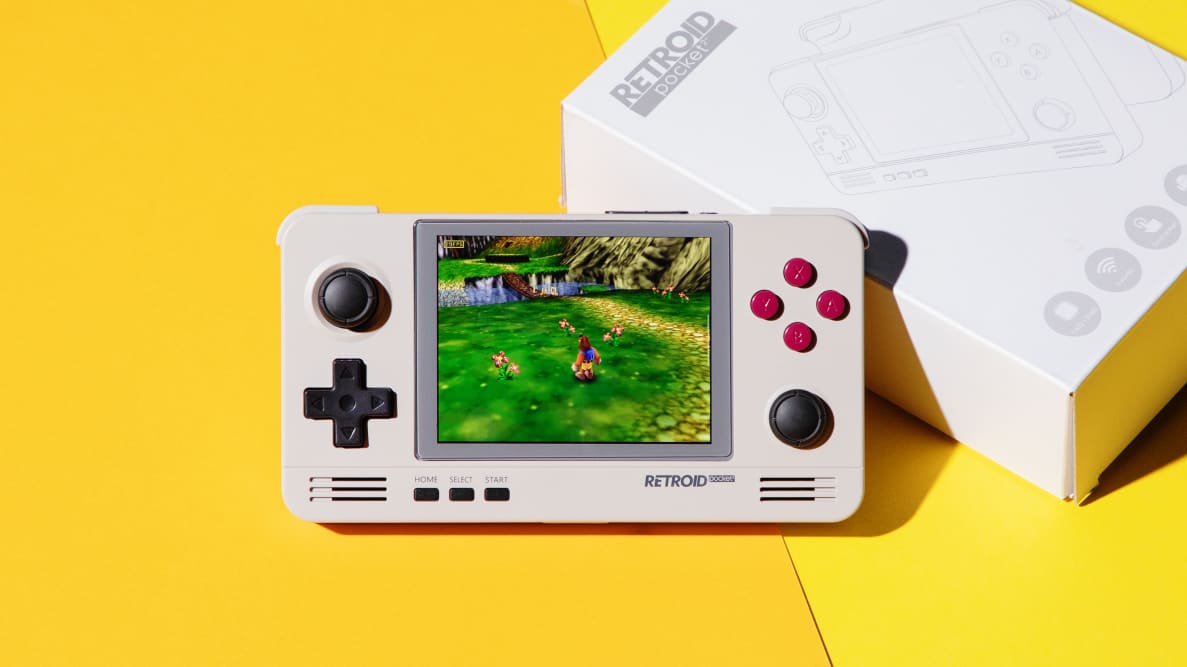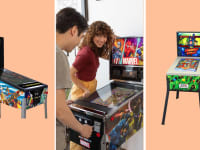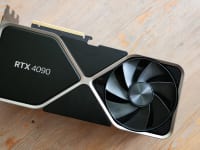Pros
-
Excellent value
-
Tons of different styles
-
Packed with connectivity options
Cons
-
Inconsistent build quality
-
Small screen
Editor's note: The Pocket 2+ has since been discontinued and is unavailable to purchase from Retroid. It has been replaced with the Retroid Pocket 2S, which uses a more powerful Unisoc T610 processor, analog shoulder buttons, and full Hall effect thumbsticks.
About the Retroid Pocket 2+
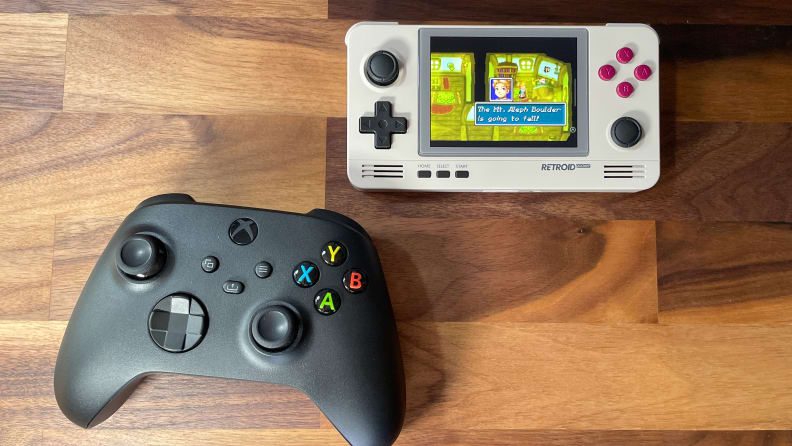
This handheld is only slightly larger than the full-sized iPhone 13.
Here are the specs of the handheld console we tested:
- Price: $99
- Processor: Unisoc Quad-core Tiger T310
- Graphics: PowerVR GE8300
- Memory: 2GB LPDDR4x RAM
- Storage: 32GB EMMC
- Battery: 4000mAh
- Display: 3.5 inch IPS screen, 640 x 480 pixels, touch screen
- Connectivity: Bluetooth 5.0, dual-band Wi-Fi (2.4GHz and 5.0GHz), 3.5mm headphone jack, USB-C 2.0 in (cable included), micro-HDMI out
- Operating system: Android 9.0
- Colors: Indigo, 16Bit, Black, Orange, Retro
- Dimensions: 6.02 x 3.19 x 0.79 inches
- Weight: 7.02 ounces
- Special features: Haptic feedback, pre-loaded with emulation and game streaming apps, Micro SD card slot, included screen protector
The Retroid Pocket 2+ lives up to its portable promise, being only slightly longer and wider than the full-sized iPhone 13. Retroid makes five different colorways, each of which is a throwback to classic consoles and is available for the same price. We reviewed the Retro version, which has a gray plastic shell and purple face buttons, a clear nod to the original Game Boy.
On first boot, the Retroid Pocket 2+ prompts you to switch between Retroid’s proprietary front-end app loader for easy access and a plain Android 9 skin—this can be switched between at will. The chin of the Pocket 2+ holds two front-firing speakers that direct sound toward the user without getting blocked during normal use.
Unfortunately, the Pocket 2+ is locked to this version of Android and can’t be updated.
What we like
The excellent value
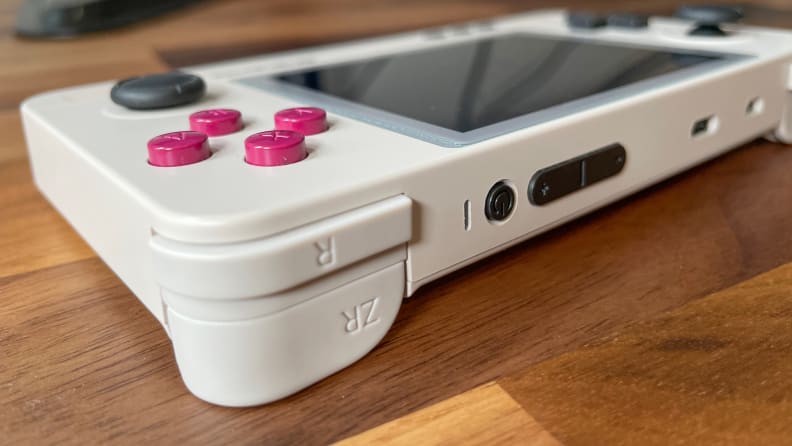
This handheld offers a ton of value relative to its sticker.
For only $99, the Retroid Pocket 2+ nets you an Android 9-based gaming handheld that will easily fit in your pants pocket.
Running Android means you can install Discord, browse the web via Chrome, listen to music, or stream your desktop to the device. All of that is before mentioning the Pocket 2+’s ability to output video to a TV. With a Bluetooth controller paired, you could easily turn it into a full-fledged retro gaming console for your living room.
Compare that to other retro gaming handhelds on the market and it becomes clear that the Pocket 2+ offers much more value for the price. Anbernic’s RG351MP, a similarly priced and sized handheld that can’t fully play Nintendo 64 games, or the company’s RG351V, which transplants the same chipset into a Game Boy Color body, are both extremely popular but both are outclassed by Retroid’s offerings.
The throwback design
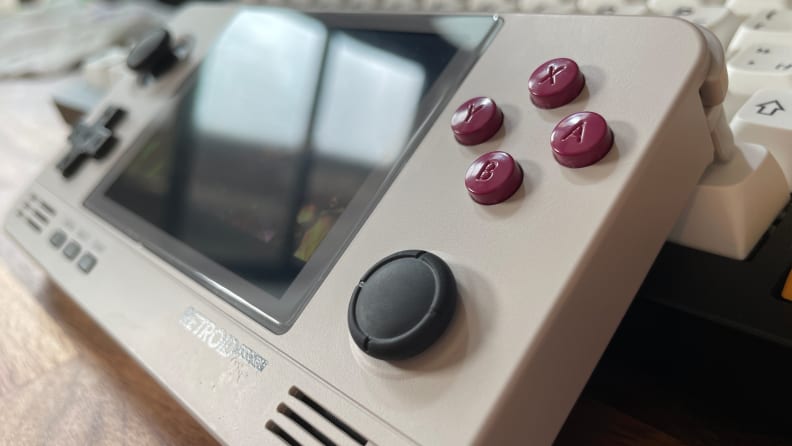
Flat all around with round corners, the design evokes the original Game Boy.
At such a low cost, you might have expected Retroid to cut costs by slashing ergonomics and design features, but the Pocket 2+ sits comfortably in my hand. It’s flat all around with rounded corners like the original Game Boy, but the shoulder buttons cantilever off the back to provide a natural resting place for your fingers when gaming.
The layout will be familiar to anyone who owns a Switch. The Pocket 2+ features two shoulder buttons on each side of the screen (not full triggers) a D-pad on the left side below a fully analog joystick, and the X, Y, B, and A buttons above a second stick on the right.
The little style flourishes on the Retroid Pocket 2+ are also worth calling attention to. Each of the available color options is a reference to an older generation of games, from the GameCube-purple handheld to the green, blue, yellow, and red face buttons on the Super Nintendo-inspired 16Bit version.
Even the boot screen cribs from the Game Boy Color’s swirl of colorful letters, as the Pocket 2+ logo curls into place when you start the system up.
Sadly, the right-hand stick is the sliding kind found on the PlayStation Portable (PSP) rather than fully articulated. Another conspicuous absence is a lack of L3 and R3 buttons; you can’t click the sticks down for additional inputs.
The performance shines for the price
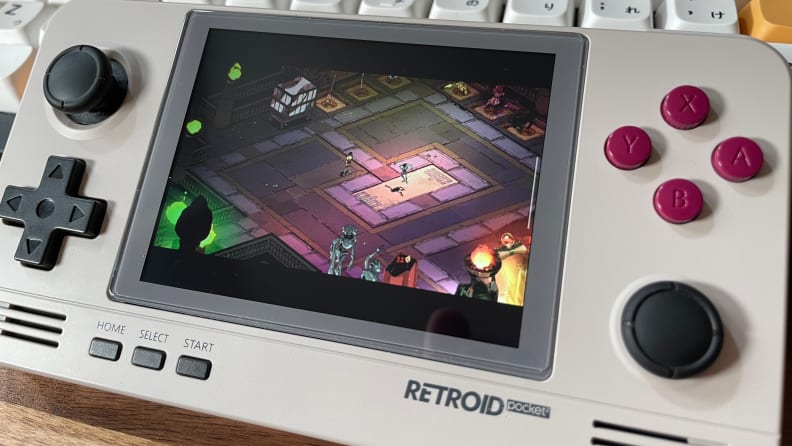
The Pocket 2+ offers smooth play across titles in all gaming generations, with only a few exceptions.
The loss of those buttons shouldn’t be too big of a deal if you’re running games natively since the Retroid Pocket 2+ shines when you’re playing Dreamcast, PlayStation 1, or Nintendo 64 games or below, which don’t use them.
This little handheld can run with the best of them—if you don’t set your expectations too high. If you want a system that can play Game Boy Advance, PlayStation, and SNES games without breaking a sweat while you commute, then the Pocket 2+ is perfect for the price.
I tested the gamut across gaming generations and the Pocket 2+ ran a huge swath of older games without issue. You’re limited to the emulators available to the Android 9 ecosystem, but what comes packed on the console works well enough—and if you want to try alternate emulation apps, you can grab them from the Google Play Store.
Final Fantasy Tactics Advance, Golden Sun, and all of the Game Boy Advance remasters of the Super Nintendo Mario games ran flawlessly through the included RetroArch app.
Moving up to more demanding titles was just as easy. I played through a few worlds in the original Banjo Kazooie for Nintendo 64, completed course circuits in Mario Kart 64, and put a few hours into the original Paper Mario through the included M64PLus FZ app, all with minimal or no slowdown. The same was true for PlayStation 1 games (for the most part). Dreamcast games all ran at full speed using the Redream emulator.
Most games ran without issue through RetroArch, but Darkstalkers 3 had a very thin graphical glitch running up the right side of the screen that wouldn’t go away. The more graphically intense Front Mission 3 refused to boot with RetroArch but ran fine through the included DuckStation emulator.
RetroArch is a great all-purpose emulator for older games that can struggle with running more recent titles, so that Retroid packs in a number of dedicated apps for more complicated consoles is a nice touch.
Trying to play more recent titles is where the Retroid Pocket 2+ falls flat. If you’re looking for something more powerful and willing to pay for it, the $239 AYN Odin or $198 Odin Lite will play Wii, GameCube, and PlayStation 2 games at full speed on a 1080p screen. Don’t expect similar performance from the Retro Pocket 2+ in this area.
Super Smash Brothers Melee dipped below 30 frames per second during matches when run on Dolphin, and Kingdom Hearts started out okay when run on the AetherSX2 emulator, but would often become unplayable during frenetic moments. Some slower-paced titles, like Paper Mario: The Thousand-Year Door will run well enough to complete but don’t expect 100% compatibility.
The Retroid community keeps a frequently updated spreadsheet of which games run well, but that’s an added layer of complexity if you just want a handheld that can run your ROMs out of the box.
What we don’t like
Small screen

The Retroid Pocket 2+ is the perfect budget option for playing everything up to the PlayStation 2 and GameCube era.
The 3.5-inch screen of the Retroid Pocket 2+ is its biggest drawback. It’s fine for reading text natively in Android or on the web, and in older games, but is unreadable when streaming newer titles. The touchscreen is a handy addition and very responsive, but the size makes it easy to miss keys when typing on the onscreen keyboard. Nothing major, but if you have larger fingers, it might be a problem.
Although PlayStation Portable games run well, the black bars on the top and bottom of the 16:9 image being emulated on a 4:3 panel will cut into your already scant screen real estate.
Because the Pocket 2+ runs on Android, you can stream games from either the cloud or your own PC over Steam Link or Moonlight. I was able to stream my PC games to the handheld without issue over Wi-Fi with Steam Link, but even though the performance was good, my results were mixed.
I tried Control, Elden Ring, and Divinity: Original Sin 2, but the image was just too small to have a good experience in any of them. The text was unreadable and it was hard to make out what was going on. You’ll have a better time emulating higher-end consoles on your PC and streaming the result to the Pocket 2+.
Build quality is hit or miss
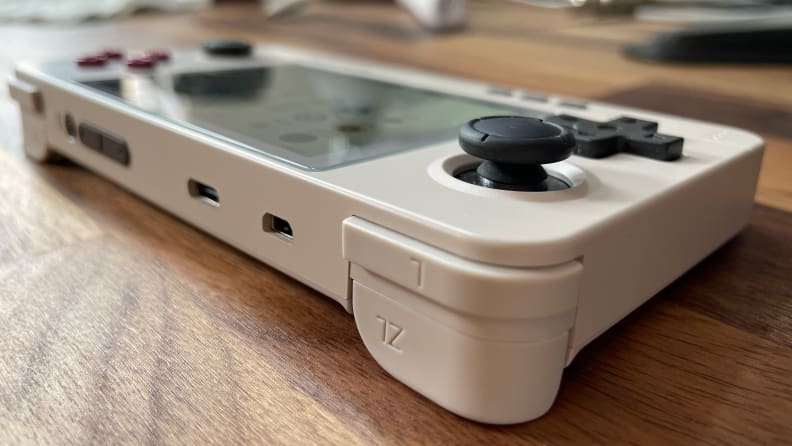
Different users have reported inconsistent build quality.
Unfortunately, quality control is a bit hit or miss with the Pocket 2+, but the variance isn’t bad enough to stave off a recommendation.
This is more of a problem with the newer Retroid Pocket 3 according to customers who pre-ordered the device and received theirs early, but the 2+ also has minor inconsistencies unit-to-unit.
While the screen on our test handheld is generally bright enough to play outdoors in the shade, some users on the Retroid subreddit have gotten units with dimmer screens, or screens that are still too bright to play at night even at the lowest brightness. This is only at the peak and lowest ends of the brightness range and these incidents are rare. There are also free third-party apps for further reducing your screen’s brightness, so it isn’t a dealbreaker in my opinion.
The face buttons on our test unit are very stiff and have a “crusty” feel to them. Generally, they’re alright in fighting games, but I missed more than one precise jump when playing 2D Mario games. This isn’t a major problem, and I haven’t seen anyone else complain about it.
The USB-C connector at the top of my unit is also a bit finicky and sometimes connects and disconnects rapidly if the cable is jostled.
Thankfully, Retroid sells every single piece of the Pocket 2+, including the shell, touch screen, buttons, different types of rubber pads for the face and D-pad buttons, and even the screws on its website. That no longer includes the PCB itself, as Retroid has phased out the Pocket 2+.
Unfortunately, Retroid doesn’t offer a warranty, though none of its competitors at this price do either.
Retroid is undercutting itself
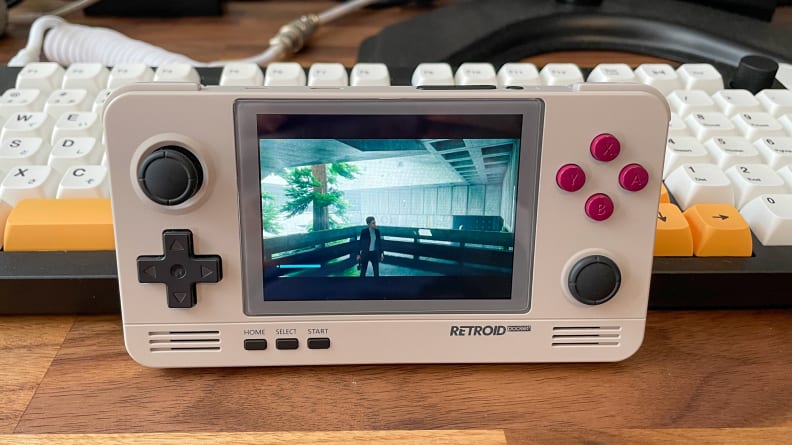
The Retroid 3, plus questionable pricing choices, cuts into the appeal of this handheld.
The biggest competitor to the Retroid Pocket 2+ is the Retroid Pocket 3, which began shipping in September of 2022.
It packs a larger 4.7-inch, 750 x 1334 pixel screen, clickable thumbsticks (both of which are the full analog type), and Android 11. Retroid claims that the Pocket 3 is 20-30% faster than the 2+, which should allow more PS2 and GameCube games to become playable.
But the Pocket 3 uses the exact same internals as the Pocket 2+ despite retailing for $20 more, or $30 if you opt for 3GB of RAM. The claimed performance bump comes solely from the software optimizations of upgrading to a newer version of Android. If you want a Pocket 3, the best use would be for streaming games.
Then there’s the Retroid Pocket 3+, which, as I noted in my review, just about fixes every issue I have with the Pocket 2+. Although it’s $50 more expensive, you’ll feel the improvement in quality.
I also can’t hold my tongue about Retroid’s pricing structure for the Pocket 2+. The handheld is technically available for $99 through Retroid’s website, but you’ll pay $15 for shipping from China and can expect to receive yours in about two weeks. If you pay $140 to buy the Pocket 2+ through Amazon, you should get it the next day. That feels like Retroid price gouging its more impatient customers.
Should you buy the Retroid Pocket 2+?
Yes, if you’re into retro gaming
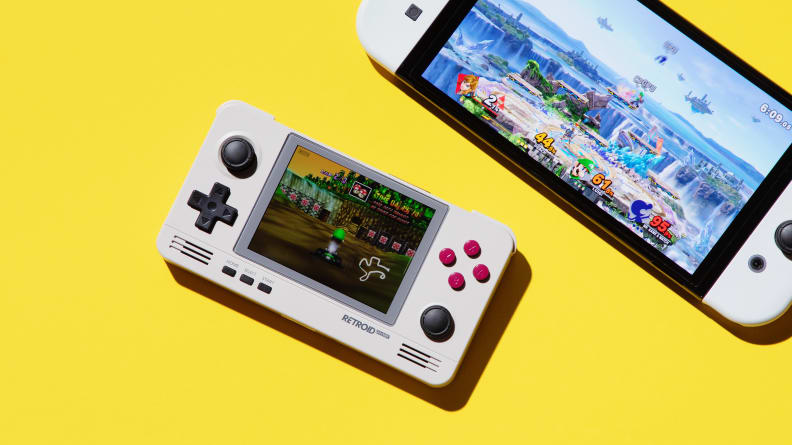
Fans of gaming yesteryear will definitely want to snap this up.
Despite its flaws, the Retroid Pocket 2+ is still the handheld gaming champion at $99. Nothing else comes close at that price point other than the more expensive Pocket 3, or a used Nintendo Switch Lite.
The Pocket 2+ will run generations of older games flawlessly and native Android games well enough. Minecraft and Stardew Valley are playable, but the text in Dead Cells was unreadable until I followed an online guide to change it in the settings.
Therein lies the biggest hurdle to buying the Pocket 2+: if you’re just dipping your toes into the world of emulation, tweaking settings for games that don’t run well, or even sourcing ROMs or console BIOS, can seem overwhelming. Playing around with the handheld brought back fond memories of getting emulators set up on my PSP, but if this is your first time, expect to read a few guides on getting started before you jump in.
There are definitely better options out there, and an ocean of worse ones. The Anbernic RG552 is popular, featuring a 5.36 inch 1920 x 1152 pixel IPS screen and 4GB of RAM, but it costs twice as much as the Pocket 2+ and only runs about as well.
The Steam Deck will handle anything you throw at it and can run up to Nintendo Switch games and beyond with no problem, but the cheapest model starts at $399.
For most people, the Retroid Pocket 2+ delivers more than enough power at a price that can’t be beat. Buy the Retroid Pocket 2+ from Amazon
Meet the tester
Jonathan is an Electronics Editor for Reviewed specializing in gaming gear and has experience with everything from controllers to benchmarking the latest GPUs. He was previously the Web Editor at The Architect's Newspaper.
Checking our work.
Our team is here for one purpose: to help you buy the best stuff and love what you own. Our writers, editors, and lab technicians obsess over the products we cover to make sure you're confident and satisfied. Have a different opinion about something we recommend? Email us and we'll compare notes.
Shoot us an email
